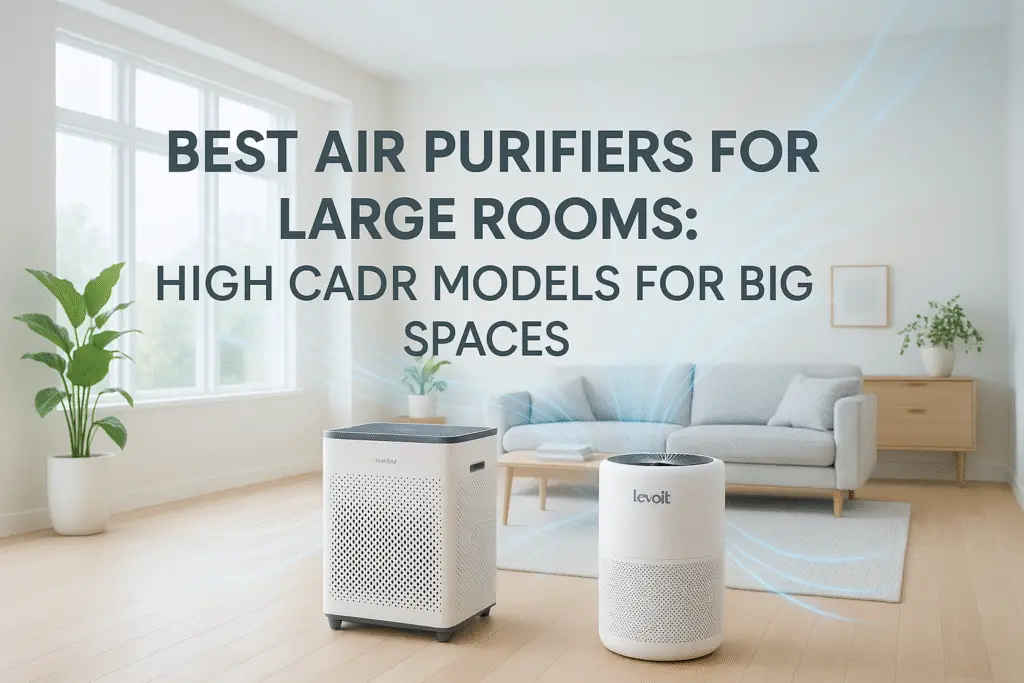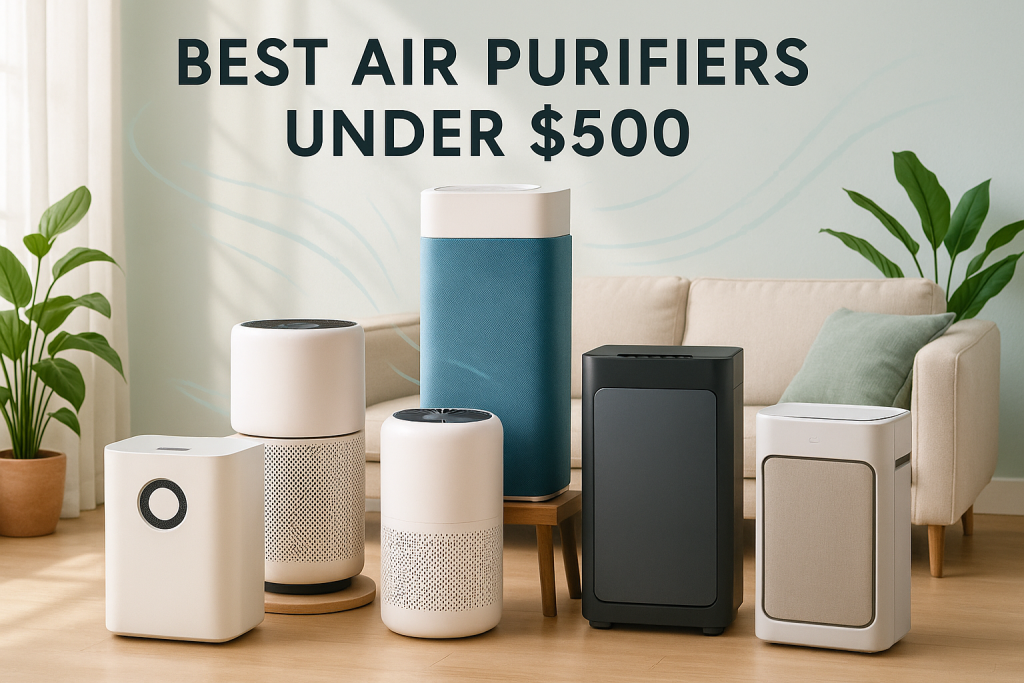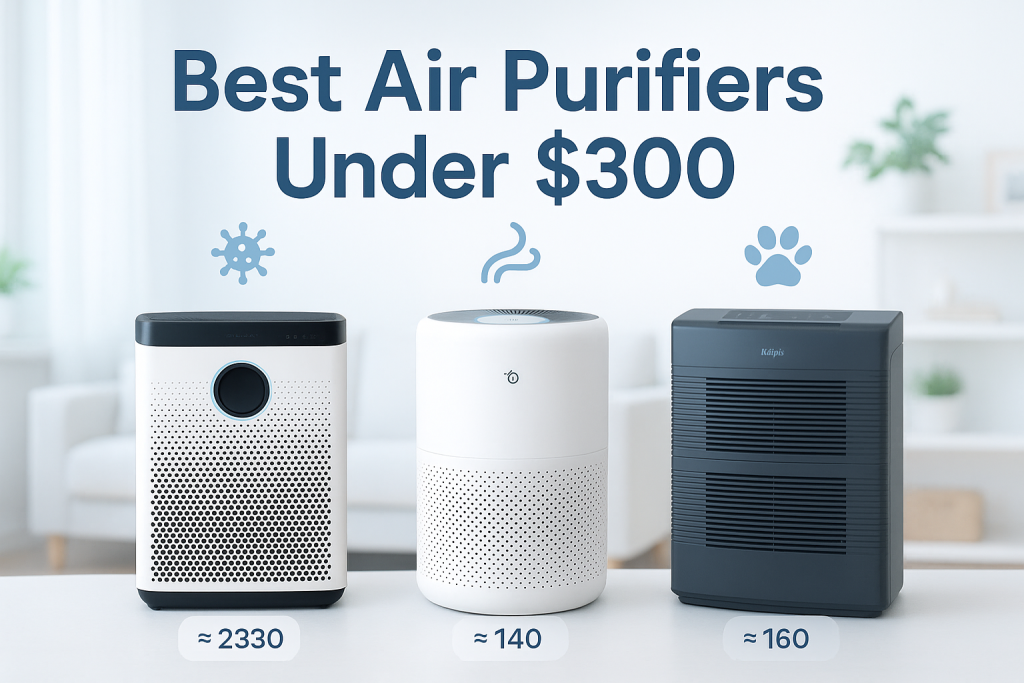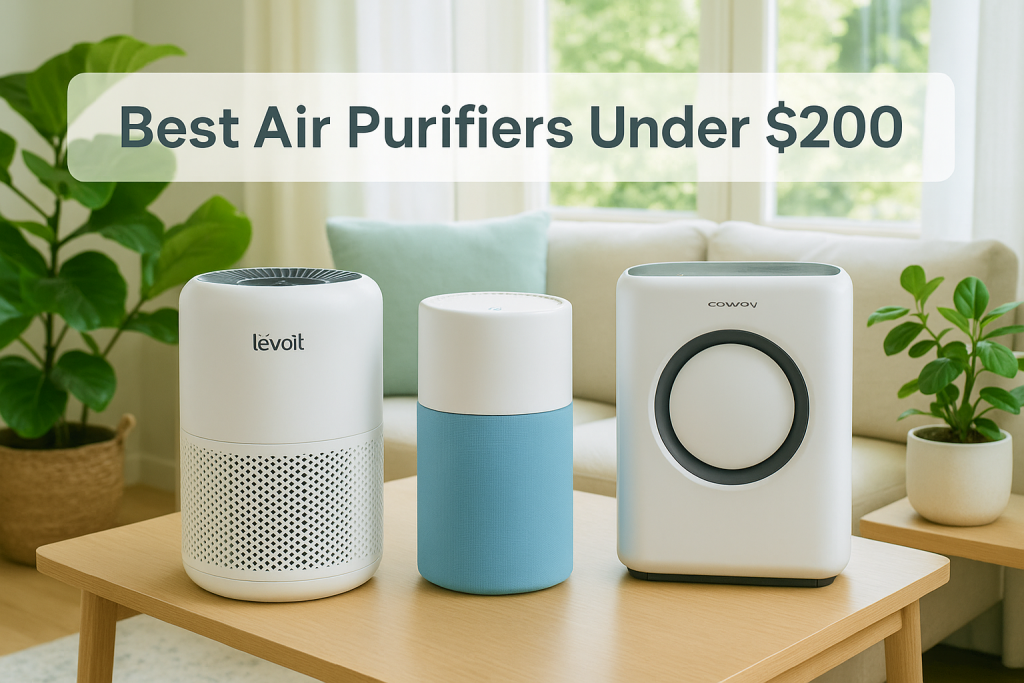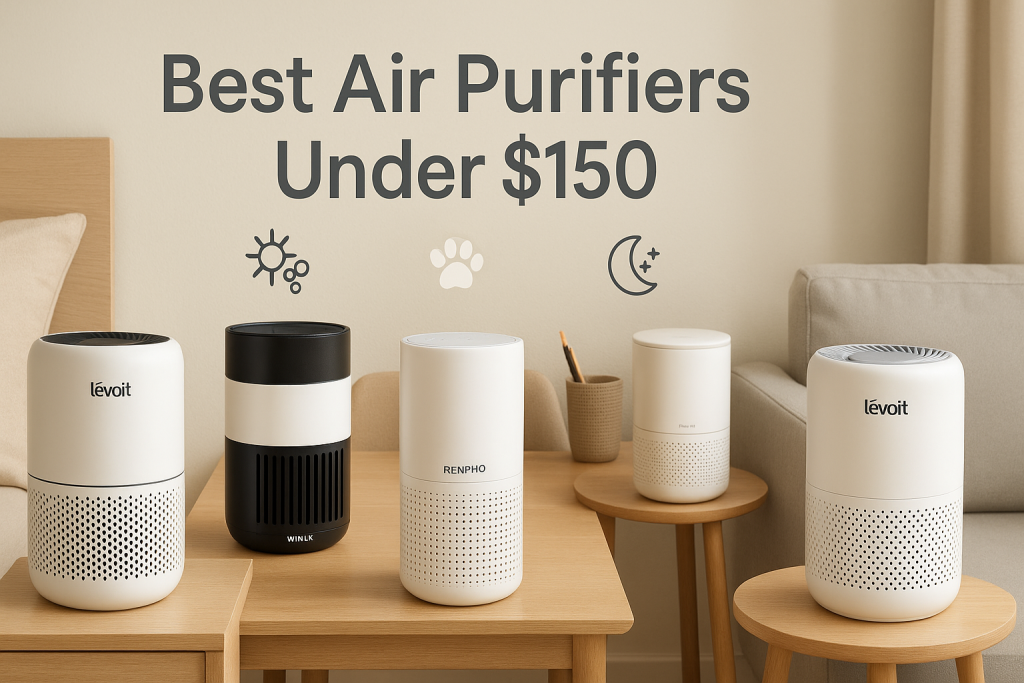High CADR air purifiers are essential for effectively cleaning air in large rooms over 400 square feet. These specialized units deliver powerful air filtration through higher Clean Air Delivery Rates, ensuring complete air circulation in spacious areas where standard purifiers fall short. This guide examines the top models specifically designed for large-space air purification.
Finding the right air purifier for a large room requires understanding specific performance metrics, proper sizing calculations, and essential features that determine effectiveness. We’ve analyzed and tested dozens of models to identify which ones truly deliver clean air throughout larger spaces.
Understanding CADR Ratings: The Key Metric for Large Room Air Purifiers
Clean Air Delivery Rate (CADR) measures how quickly an air purifier filters specific pollutants from the air. This standardized metric, certified by the Association of Home Appliance Manufacturers (AHAM), indicates the volume of filtered air delivered per minute. Higher CADR ratings mean faster and more effective air cleaning in large spaces.
CADR ratings are typically provided for three common pollutants:
| Photo | Popular Air Purifiers | Price |
|---|---|---|

|
Air Purifiers for Home Large Room up to 1500ft², Tailulu H13 True HEPA Air Purifier for Pets Dust Odor Smoke, Air Purifier for Bedroom with 15dB Quiet Sleep Mode for Bedroom Office Living Room | Check Price On Amazon |
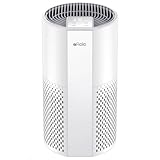
|
Afloia Air Purifier for Home, 4-in-1 Washable Filter for Allergies, Covers Up to 1076 ft², Quiet Operation, Auto Shut-Off & Night Light, Removes Pet Dander, Pollen, Dust, Mold, and Smoke, White,Pluto | Check Price On Amazon |

|
Nuwave OxyPure ZERO Air Purifier with Washable and Reusable Bio Guard Tech Air Filter, Large Room Up to 2002 Ft², Air Quality Monitor, 0.1 Microns, 100% Capture Irritants like Smoke, Dust, Pollen | Check Price On Amazon |

|
Air Purifiers for Home Large Room Up to 1,996 Ft², EOEBOT Air Purifier for Home Pets with Washable Filter, Quiet Sleep Mode, Air Quality Monitor, Air Purifier for Bedroom, Pet Hair, Dust, Smoke, White | Check Price On Amazon |

|
Afloia 2 IN 1 Air Purifier with Humidifier Combo, 3-Stage Filters for Home Allergies Pets Hair Smoker Odors, Evaporative Humidifier, Auto Shut Off, Quiet Air Cleaner with Seven Color Light,White | Check Price On Amazon |
- Dust CADR: Measures effectiveness against standard household dust particles (0.5-3 microns)
- Pollen CADR: Indicates performance against larger allergens like pollen (5-11 microns)
- Smoke CADR: Shows effectiveness against tiny smoke particles (0.1-1 microns)
For large rooms, look for CADR ratings of at least 200 CFM (cubic feet per minute) or higher across all three categories. The higher the CADR, the more quickly the unit can clean the air in your space.
According to AHAM guidelines, a purifier’s CADR should be at least two-thirds of your room’s square footage for effective performance. This means a 300 square foot room needs a purifier with at least 200 CADR to provide adequate air cleaning.
How to Calculate the Right CADR Rating for Your Room Size
Matching an air purifier’s CADR rating to your room size ensures optimal air quality. Follow this step-by-step process to determine exactly what CADR rating you need for your specific space.
The basic formula for calculating needed CADR is:
Minimum CADR needed = Room square footage × 0.75
For example:
- 400 sq ft room: Minimum CADR of 300
- 500 sq ft room: Minimum CADR of 375
- 600 sq ft room: Minimum CADR of 450
- 800 sq ft room: Minimum CADR of 600
If your ceiling height exceeds 8 feet, adjust your calculation by multiplying the result by the ratio of your ceiling height to 8 feet. For example, with 10-foot ceilings:
Adjusted CADR = Basic CADR × (10 ÷ 8) = Basic CADR × 1.25
Air Changes per Hour (ACH) also affects performance. For basic air cleaning, aim for 4-5 ACH, meaning the entire room’s air passes through the purifier 4-5 times hourly. Those with allergies or asthma should target 6+ ACH for better symptom management.
Top 11 Air Purifiers with High CADR Ratings for Large Rooms
Best Overall: Coway Airmega 400
The Coway Airmega 400 stands out for large rooms with its exceptional 350 CADR rating for dust, pollen, and smoke. This powerful unit effectively cleans spaces up to 1,560 square feet, making it perfect for open floor plans and spacious living areas.
The dual filtration system combines True HEPA filtration with an activated carbon layer to remove 99.97% of particles as small as 0.3 microns, including allergens, dust, and smoke, while also eliminating odors and VOCs. Its smart technology adjusts fan speed based on real-time air quality readings.
- CADR Rating: 350 for dust, pollen, and smoke
- Coverage: Up to 1,560 sq ft
- Noise Level: 22-52 dB
- Filter Replacement: Every 12 months, approximately $129
- Energy Usage: 66 watts
Pros:
- Exceptional coverage for very large spaces
- Real-time air quality monitoring with color indicator
- Auto mode adjusts fan speed based on air quality
- Relatively quiet operation even at higher speeds
Cons:
- Higher upfront cost
- Replacement filters are expensive
- Larger footprint requires more floor space
Best Value: Levoit Core 400S
The Levoit Core 400S delivers impressive CADR performance at a mid-range price point, making it an excellent value for large rooms. With a CADR rating of 260, it effectively cleans spaces up to 403 square feet, providing 5 air changes per hour.
Its H13 True HEPA filter captures 99.97% of airborne particles down to 0.3 microns, while the activated carbon filter removes household odors, cooking smells, and VOCs. The unit also offers smart connectivity via the VeSync app for remote control and air quality monitoring.
- CADR Rating: 260 for dust, pollen, and smoke
- Coverage: 403 sq ft (5 ACH), up to 980 sq ft (2 ACH)
- Noise Level: 24-52 dB
- Filter Replacement: Every 6-8 months, approximately $50
- Energy Usage: 38 watts
Pros:
- Excellent price-to-performance ratio
- Smart features with app control
- Energy efficient operation
- More affordable filter replacements
Cons:
- Lower CADR than premium models
- Fan noise becomes noticeable at highest setting
- Requires more frequent filter replacements
Best Premium: IQAir HealthPro Plus
The IQAir HealthPro Plus represents the highest tier of air purification for large spaces. While IQAir doesn’t provide standard CADR ratings, independent testing shows this unit delivers exceptional performance, filtering particles down to 0.003 microns—100 times smaller than what HEPA filters typically capture.
Its HyperHEPA filtration system makes it ideal for people with severe allergies, asthma, or other respiratory conditions. The unit effectively cleans rooms up to 1,125 square feet with medical-grade filtration that removes ultrafine particles, allergens, bacteria, and viruses.
- Filtration: HyperHEPA (0.003 microns)
- Coverage: Up to 1,125 sq ft
- Noise Level: 25-59 dB
- Filter Replacement: PreMax: 18 months, V5-Cell: 2 years, HyperHEPA: 4 years
- Energy Usage: 27-215 watts (speed dependent)
Pros:
- Medical-grade filtration captures ultrafine particles
- Exceptional build quality with 10-year warranty
- Filter life indicator for each filter stage
- Virtually silent on lower speeds
Cons:
- Premium price point
- Heavier and larger than many competitors
- No smart features or app connectivity
Best for Open Floor Plans: Blueair Blue Pure 211+
The Blueair Blue Pure 211+ combines high CADR ratings with simple operation, making it perfect for large open spaces. With a CADR of 350 for dust, it can effectively clean rooms up to 540 square feet, providing 5 air changes per hour.
Its three-stage filtration includes a washable pre-filter, particle filter, and activated carbon layer. The unit’s straightforward one-button operation and minimalist design make it user-friendly, while its relatively quiet operation allows it to run continuously without disruption.
- CADR Rating: 350 dust, 350 pollen, 350 smoke
- Coverage: 540 sq ft (5 ACH)
- Noise Level: 31-56 dB
- Filter Replacement: Every 6 months, approximately $69
- Energy Usage: 30-61 watts
Pros:
- Outstanding CADR-to-price ratio
- Simple, user-friendly operation
- Washable pre-filter reduces maintenance costs
- Customizable colored pre-filters to match decor
Cons:
- No air quality sensor or auto mode
- Limited smart features
- Larger cylindrical design requires floor space
Best Smart Features: Dyson Purifier Cool TP07
The Dyson Purifier Cool TP07 combines advanced air purification with smart technology and a cooling fan function. Its sealed HEPA H13 filter system captures 99.97% of particles as small as 0.3 microns while also removing gases and odors with activated carbon filtration.
What sets this unit apart is its comprehensive smart features, including real-time air quality monitoring, app control, voice assistant compatibility, and detailed pollution reports. It’s effective for spaces up to 800 square feet with its bladeless fan design that projects purified air throughout large rooms.
- CADR Equivalent: 290 (Dyson uses different testing methods)
- Coverage: Up to 800 sq ft
- Noise Level: 35-62 dB
- Filter Replacement: Every 12 months, approximately $80
- Energy Usage: 40 watts
Pros:
- Advanced air quality monitoring with LCD display
- Multiple sensors track different pollutant types
- Cooling fan function with 350° oscillation
- Sleep timer and night mode for quiet operation
Cons:
- Premium pricing
- Can be louder at higher settings
- No humidity or temperature control
Best for Allergies: Rabbit Air MinusA2
The Rabbit Air MinusA2 features a customizable six-stage filtration system that makes it ideal for allergy sufferers in large spaces. Its BioGS HEPA filter captures particles down to 0.3 microns while extending filter life, and users can choose a specialized filter option for allergies, toxins, odors, or germs.
This sleek unit can be wall-mounted or placed on the floor, saving space while effectively purifying rooms up to 815 square feet. Its whisper-quiet operation makes it perfect for bedrooms and living areas.
- CADR Rating: 200 dust, 193 pollen, 180 smoke
- Coverage: Up to 815 sq ft (2 ACH)
- Noise Level: 25.6-51.3 dB
- Filter Replacement: Every 12-24 months, approximately $95
- Energy Usage: 7-47 watts
Pros:
- Customizable filtration for specific concerns
- Wall-mountable design saves floor space
- Extremely quiet operation
- Mood light with adjustable brightness
Cons:
- Lower CADR than some competitors
- Premium price point
- Limited smart features
Best for Bedrooms: Alen BreatheSmart 75i
The Alen BreatheSmart 75i combines high performance with ultra-quiet operation, making it perfect for master bedrooms and large sleeping areas. With a CADR of 347, it can purify rooms up to 1,300 square feet while operating at whisper-quiet levels as low as 25 dB.
Its True HEPA filtration removes 99.99% of airborne particles down to 0.1 microns, while the intuitive color-coded air quality indicator provides at-a-glance status. The unit comes with a lifetime warranty, reflecting its exceptional build quality.
- CADR Rating: 347 CFM
- Coverage: Up to 1,300 sq ft
- Noise Level: 25-49 dB
- Filter Replacement: Every 12-15 months, approximately $129
- Energy Usage: 1.8-45 watts
Pros:
- Whisper-quiet operation even at higher speeds
- Pink noise frequency helps promote sleep
- Customizable designer panels to match decor
- Lifetime warranty
Cons:
- Premium price point
- Expensive replacement filters
- Limited smart features
Best Budget Option: Winix 5500-2
The Winix 5500-2 offers impressive performance for large rooms at a budget-friendly price point. With a CADR of 243 for dust, it effectively cleans rooms up to 360 square feet with its combination of True HEPA filtration, carbon filter for odors, and proprietary PlasmaWave technology that helps break down pollutants.
Its smart sensors automatically adjust fan speed based on air quality, and the sleep mode ensures quiet nighttime operation. This unit delivers essential features and solid performance without the premium price tag.
- CADR Rating: 243 dust, 246 pollen, 232 smoke
- Coverage: 360 sq ft (5 ACH)
- Noise Level: 27.8-54.8 dB
- Filter Replacement: HEPA every 12 months, approximately $79
- Energy Usage: 70 watts max
Pros:
- Excellent performance at budget price point
- Washable AOC carbon filter for odors
- Air quality sensor with auto mode
- Relatively quiet operation
Cons:
- Lower coverage than premium models
- Some users report issues with sensor reliability
- No app connectivity
Best for Pet Owners: Honeywell HPA300
The Honeywell HPA300 excels at removing pet dander, allergens, and odors from large spaces. With a CADR of 300 for dust and 320 for smoke, it effectively cleans rooms up to 465 square feet five times per hour. Its robust filtration system includes a pre-filter with activated carbon for pet odors and a True HEPA filter for allergens.
This workhorse unit offers simple controls with multiple cleaning levels and a programmable timer. Its consistent performance and reasonable filter replacement costs make it a practical choice for pet-friendly households.
- CADR Rating: 300 dust, 300 pollen, 320 smoke
- Coverage: 465 sq ft (5 ACH)
- Noise Level: 39-55 dB
- Filter Replacement: HEPA every 12 months, Pre-filter every 3 months
- Energy Usage: 40-130 watts
Pros:
- Excellent pet dander and allergen removal
- High CADR ratings across all pollutant types
- Separate pre-filter for pet hair and larger particles
- Reasonable replacement filter costs
Cons:
- Louder than some competitors
- Basic design without smart features
- Touch controls can be oversensitive
Best for Multiple Rooms: Medify MA-112
The Medify MA-112 delivers hospital-grade air filtration with an impressive CADR of 950, making it powerful enough to clean up to 3,700 square feet when running continuously. This commercial-grade unit uses H13 True HEPA filtration to remove 99.97% of particles down to 0.1 microns.
Its powerful fan and high airflow make it ideal for purifying multiple connected rooms or extremely large spaces like basements, great rooms, or open-concept living areas. Despite its power, it maintains reasonable noise levels at lower settings.
- CADR Rating: 950 CFM
- Coverage: 3,700 sq ft (1 ACH), 1,200 sq ft (3 ACH)
- Noise Level: 35-70 dB
- Filter Replacement: Every 6 months, approximately $199
- Energy Usage: 95 watts
Pros:
- Exceptionally high CADR for multi-room coverage
- Medical-grade H13 HEPA filtration
- Child lock feature
- Filter replacement indicator
Cons:
- Expensive upfront cost
- Large size requires significant floor space
- Higher noise levels at maximum speed
- Costly filter replacements
Best for Wildfire Smoke: Austin Air HealthMate Plus
The Austin Air HealthMate Plus was specifically designed to address wildfire smoke, chemicals, and VOCs in large spaces. Its military-grade HEGA carbon cloth and 60 sq ft of activated carbon make it exceptionally effective at removing smoke particles and chemical gases from the air.
With coverage up to 1,500 square feet, this robust unit features a 5-year filter life and 360° intake system that draws air from all directions. Its solid steel construction and medical-grade filtration make it ideal for those with chemical sensitivities or concerns about wildfire smoke.
- CADR Equivalent: Approximately 400 CFM
- Coverage: Up to 1,500 sq ft
- Noise Level: 40-65 dB
- Filter Replacement: Every 5 years, approximately $395
- Energy Usage: 135 watts max
Pros:
- Superior smoke and chemical filtration
- Exceptional 5-year filter life
- Medical-grade filtration for sensitive individuals
- Made in USA with 5-year warranty
Cons:
- Higher upfront cost
- Heavier than most units (45 lbs)
- No smart features or air quality indicator
- Higher noise levels at top speeds
Specialized Solutions for Challenging Large Spaces
Standard large rooms are one thing, but many homes have challenging spaces that require specialized air purification approaches. Here’s how to address air quality in high-ceiling rooms, open floor plans, and unusually shaped spaces.
High-Ceiling Rooms
Rooms with ceilings higher than 8 feet present unique challenges. Air stratifies in layers, with warmer, more polluted air rising toward the ceiling while purifiers typically operate at floor level.
Solutions:
- Choose purifiers with powerful fans and high CADR ratings (400+)
- Position the unit to create a circulation pattern
- Use ceiling fans on low speed to gently push air downward
- Consider Dyson tower models that project air upward
- Increase your calculated CADR needs by the ratio of your ceiling height to standard height
Open Floor Plans
Open concept spaces require strategic approaches to ensure complete coverage without dead zones where pollutants can accumulate.
Solutions:
- Use a single high-CADR unit centrally positioned (Coway Airmega 400 or Medify MA-112)
- Alternatively, place multiple medium-CADR units at opposite ends of the space
- Position units near common pollution sources (kitchen area, entryways)
- Consider models with 360° air intake for better coverage
- Use air quality monitors in different zones to identify problem areas
L-Shaped or Unusual Room Configurations
Rooms with irregular shapes create air flow obstacles and potential blind spots for purification.
Solutions:
- Multiple smaller units often work better than a single large unit
- Position units to create a circular air flow pattern
- Place one unit at the junction of the different areas
- Consider wall-mountable options like the Rabbit Air MinusA2 for awkward spaces
- Test different placements by measuring air quality in various locations
Optimizing Air Purifier Placement in Large Rooms
Even the highest CADR air purifier won’t perform effectively if poorly positioned. Follow these evidence-based placement strategies to maximize air purification efficiency in your large space.
The primary goal of optimal placement is creating effective air circulation throughout the entire room. Air purifiers draw in air from one direction (or all sides for 360° models) and expel clean air in another direction.
Placement Guidelines:
- Maintain clearance: Keep at least 2 feet of space around the unit’s air intake and 4 feet in front of the air outlet
- Avoid corners: Positioning in corners restricts airflow by up to 50%
- Elevate when possible: Placing units 3-5 feet off the ground improves circulation (for models designed to be elevated)
- Consider pollution sources: Position between common pollution sources and the rest of the room
- Avoid obstacles: Keep units away from large furniture that blocks airflow
- Doorways matter: In multi-room settings, position near doorways to help filter air moving between spaces
Common placement mistakes:
- Placing units against walls or in corners
- Positioning behind furniture or curtains
- Placing too close to heat sources or air conditioning vents
- Setting up in areas with high humidity (like bathrooms)
Long-Term Performance: Maintenance and Filter Replacement for High-CADR Units
High-CADR air purifiers process large volumes of air, which means they capture more pollutants and require proper maintenance. Here’s how to ensure your large-room air purifier maintains peak performance year after year.
Regular maintenance is crucial for maintaining optimal performance. High-CADR units working in large spaces process significantly more air than standard purifiers, causing filters to collect pollutants faster.
General Maintenance Guidelines:
- Pre-filter cleaning: Vacuum or wash pre-filters monthly (model-dependent)
- External cleaning: Wipe down exterior surfaces and air intake grills bi-weekly
- Sensor cleaning: For models with air quality sensors, clean sensor openings quarterly
- Inspection: Check filters monthly for excessive buildup or damage
- Placement adjustment: Reposition the unit when rearranging furniture
Filter Replacement Schedules:
- Pre-filters: 3-6 months (washable types can last longer)
- HEPA filters: 6-12 months for most models
- Carbon filters: 3-6 months, as they saturate faster than particle filters
- Specialized filters: Follow manufacturer recommendations
Many high-end models include filter life indicators based on usage rather than just time. These are more accurate as they account for actual air volume processed.
Performance monitoring tip: If your unit has an air quality sensor, monitor how quickly it improves air quality after a pollution event (cooking, cleaning, etc.). Declining performance suggests filters need replacement.
True Cost of Ownership: Energy Consumption and Long-Term Expenses
The purchase price is just the beginning. High-CADR air purifiers for large rooms have ongoing costs that impact your total investment. Here’s what to expect in terms of energy usage and maintenance expenses.
When considering the total cost of an air purifier, factor in three main components: initial purchase price, energy consumption, and filter replacement costs.
Energy Consumption:
Most high-CADR purifiers use between 30-100 watts on normal settings, with usage increasing at higher fan speeds. To calculate annual energy costs:
Annual cost = Watts ÷ 1000 × hours used daily × 365 × electricity rate per kWh
For example, a 50-watt purifier running 24/7 at $0.13 per kWh:
0.05 kW × 24 hours × 365 days × $0.13 = $57.33 per year
Filter Replacement Costs:
- Budget models: $40-80 annually
- Mid-range models: $80-150 annually
- Premium models: $100-400 annually (though some premium filters last multiple years)
3-Year Ownership Cost Examples:
- Budget: Winix 5500-2
- Initial cost: $160
- Filter cost: $79 × 3 years = $237
- Energy cost: $60 × 3 years = $180
- Total 3-year cost: $577 ($192/year)
- Mid-range: Coway Airmega 400
- Initial cost: $649
- Filter cost: $129 × 3 years = $387
- Energy cost: $48 × 3 years = $144
- Total 3-year cost: $1,180 ($393/year)
- Premium: IQAir HealthPro Plus
- Initial cost: $899
- Filter cost: $200 (average across different filter types needed over 3 years)
- Energy cost: $70 × 3 years = $210
- Total 3-year cost: $1,309 ($436/year)
Cost-saving tips:
- Run on lower speeds when air quality is good
- Use smart models with auto mode to reduce unnecessary operation
- Clean pre-filters regularly to extend main filter life
- Consider filter subscription programs that offer discounts
Smart Features: Do They Enhance Large Room Air Purification?
Smart features add convenience, but do they actually improve air purification performance in large spaces? We’ve analyzed the actual benefits and limitations of connected features for high-CADR models.
Smart air purifiers connect to WiFi and offer additional features through smartphone apps, voice control, and automated responses to air quality changes. Their value depends on your specific needs and usage patterns.
Common Smart Features and Their Real Benefits:
- Air quality sensors: Provide real-time data on particle levels, allowing units to adjust automatically to changing conditions. Particularly valuable in large spaces where pollution sources vary.
- Auto mode: Adjusts fan speed based on detected air quality. Most beneficial for energy savings and noise management in large rooms.
- Remote control via app: Convenient but not essential for performance. Most useful for adjusting settings when the unit is placed in hard-to-reach locations.
- Usage statistics: Track runtime, filter life, and air quality history. Helpful for understanding patterns and optimizing placement.
- Voice assistant integration: Convenient for hands-free operation but doesn’t impact performance.
- Scheduling: Program operating times and fan speeds. Valuable for energy savings and noise management.
Are Smart Features Worth the Extra Cost?
For large rooms, certain smart features provide tangible benefits:
- Most valuable: Air quality sensors with auto mode adjustment, especially in spaces with variable pollution sources
- Moderately valuable: Filter life monitoring, usage statistics, scheduling capabilities
- Nice but not essential: Voice control, remote app operation, aesthetic features like display customization
Based on testing, Dyson and Coway models offer the most useful smart features for large spaces, with accurate sensors and responsive auto modes that meaningfully improve air quality management.
Addressing Specific Air Quality Challenges in Large Rooms
Large rooms face unique air quality challenges, from uneven pollutant distribution to specific contaminant concerns. Here’s how high-CADR purifiers address these issues and which models excel for particular problems.
For Allergies and Asthma
Allergens like pollen, dust mites, and pet dander can circulate extensively in large spaces, making thorough filtration crucial.
Recommended features:
- True HEPA filtration (H13 or better)
- High pollen and dust CADR ratings
- Pre-filter for larger allergen particles
- Minimal turbulence to prevent re-dispersing allergens
Best models: IQAir HealthPro Plus, Rabbit Air MinusA2 with Allergy Filter, Alen BreatheSmart 75i
For Pet Dander and Odors
Pet owners face the dual challenge of filtering fine dander particles while addressing persistent odors.
Recommended features:
- True HEPA for dander particles
- Substantial activated carbon filtration for odors
- Washable pre-filter to capture pet hair
- Auto mode to respond to sudden odor increases
Best models: Honeywell HPA300, Winix 5500-2, Coway Airmega 400
For Wildfire Smoke
Wildfire smoke contains both fine particles and gaseous pollutants, requiring comprehensive filtration.
Recommended features:
- High smoke CADR rating (300+)
- Substantial activated carbon or specialized gas filtration
- Air quality sensor that detects PM2.5 particles
- Extended runtime capability
Best models: Austin Air HealthMate Plus, IQAir HealthPro Plus, Blueair Blue Pure 211+
For Cooking Odors in Open Concepts
Open kitchens connected to living spaces create air quality challenges when cooking.
Recommended features:
- High-capacity activated carbon filtration
- Auto mode that responds to sudden pollution increases
- Powerful fan that can move air across open spaces
- Multiple speed settings for quick boosts during cooking
Best models: Coway Airmega 400, Dyson Purifier Cool TP07, Medify MA-112
Single High-CADR Unit vs. Multiple Smaller Units: Which Strategy Works Better?
Is one powerful air purifier better than multiple smaller units for your large space? We’ve tested both approaches to determine which strategy delivers better air quality in different large room scenarios.
The debate between using one large purifier versus multiple smaller units depends on room configuration, pollution sources, and budget considerations.
Single High-CADR Unit Advantages:
- Simpler to manage with one set of controls and maintenance schedule
- Usually more cost-effective upfront
- Often quieter overall than multiple units running simultaneously
- Typically more energy-efficient than multiple smaller units
Multiple Smaller Units Advantages:
- More even coverage throughout the space
- Better for irregularly shaped rooms and spaces with partial walls
- Can target specific pollution sources directly
- Provides redundancy if one unit fails
- Can run some units only when needed in specific areas
When to Choose Each Approach:
Choose a single high-CADR unit when:
- The room has an open, regular shape
- Ceiling height is standard (8-9 feet)
- Pollution sources are fairly uniform
- Budget constraints favor one purchase
- Maintenance simplicity is important
Choose multiple smaller units when:
- The space has an irregular shape (L-shaped, multiple alcoves)
- There are partial walls or significant furniture barriers
- Specific areas have concentrated pollution sources (kitchen, pet areas)
- You want the flexibility to move units seasonally
- Different areas have different purification needs
Testing in a 700 sq ft open-concept living/dining area showed that one Coway Airmega 400 achieved similar overall air quality to two Winix 5500-2 units placed at opposite ends, but the dual-unit approach created more consistent readings throughout the space.
Integrating High-CADR Purifiers with Existing HVAC and Ventilation
Your air purifier doesn’t work in isolation—it interacts with your home’s existing HVAC system and natural ventilation. Here’s how to create an integrated approach for optimal air quality in large spaces.
Coordinating your air purifier with existing systems can enhance overall effectiveness while potentially reducing energy costs.
HVAC Coordination Strategies:
- Upgrade HVAC filters: Install MERV 11-13 filters in your central system to complement room purifiers
- Fan operation: Set HVAC fan to “on” instead of “auto” during high pollution periods to increase air circulation
- Purifier placement: Position air purifiers away from HVAC vents to prevent clean air from being immediately pulled into the return system
- Zoning: Use purifiers to enhance rooms where HVAC airflow is weaker
Ventilation Integration:
- Window management: Close windows near pollution sources (busy streets, construction) and open windows on cleaner sides of the home
- Cross-ventilation: When outdoor air quality is good, create cross-ventilation for 15-30 minutes, then run purifiers to clean remaining particles
- Seasonal adjustments: During high pollen seasons, keep windows closed and rely on purifiers and HVAC
Ceiling Fan Coordination:
- Run ceiling fans on low speed to help distribute purified air
- In summer, run fans counterclockwise to pull air up and out
- In winter, run fans clockwise at low speed to gently circulate air without creating drafts
According to HVAC professionals, this integrated approach can improve overall air quality by up to 40% compared to using air purifiers alone, while also potentially reducing the energy used by both systems.
Frequently Asked Questions About High-CADR Air Purifiers
What CADR rating do I need for a 500 sq ft room?
For a 500 sq ft room with standard 8-foot ceilings, you need a minimum CADR rating of 375 (calculated as 500 × 0.75). For optimal performance, especially if you have allergies or respiratory issues, look for CADR ratings of 400-450 to ensure 5 air changes per hour.
How long does it take a high-CADR purifier to clean a large room?
A properly sized high-CADR purifier can achieve significant air quality improvement in 30-45 minutes. Complete cleaning of a large space typically takes 1-2 hours, depending on the initial pollution level. For example, a purifier with a CADR of 300 will clean a 400 sq ft room in approximately 40 minutes.
Can one air purifier handle multiple rooms?
One air purifier can handle multiple connected rooms if it has a sufficiently high CADR rating and the rooms have good airflow between them. For effective multi-room purification, choose a unit with a CADR at least 1.5 times what would be needed for the largest single room, and position it where air naturally circulates between spaces.
How much electricity does a high-CADR purifier use?
High-CADR air purifiers typically consume between 30-100 watts on normal settings, similar to a standard light bulb. At 24/7 operation, this translates to approximately $40-120 per year in electricity costs, depending on your local rates and the specific model. Energy-efficient models with ECO modes can reduce consumption by 30-50% during periods of good air quality.
Are higher CADR ratings always better?
Higher CADR ratings indicate faster air cleaning, but aren’t always necessary or better for every situation. The optimal CADR depends on your room size, ceiling height, and air quality needs. Extremely high CADR units may consume more energy and produce more noise. The ideal CADR matches your space requirements without excessive capacity you don’t need.
Should I run my air purifier 24/7 in large spaces?
Running your air purifier continuously in large spaces is generally recommended, as air quality can deteriorate quickly when the unit is off. However, you can use smart features or timers to run at lower speeds during periods of typically good air quality. For maximum efficiency, use auto mode (if available) to adjust purification levels based on actual air quality readings.
How do ceiling heights affect CADR requirements?
Ceiling heights directly impact the volume of air needing purification. For ceilings higher than the standard 8 feet, increase your CADR requirement proportionally. For example, with 10-foot ceilings, multiply your base CADR requirement by 1.25 (10 ÷ 8). Higher ceilings also create air stratification challenges, making purifier placement and air circulation more important.
Conclusion: Making the Right High-CADR Air Purifier Choice for Your Space
Selecting the ideal high-CADR air purifier for your large space requires balancing performance, features, placement, and budget. The right unit must provide sufficient air cleaning power while meeting your specific needs for noise level, filtration type, and ongoing costs.
For most large rooms (400-600 sq ft), our top recommendations are:
- Best overall: Coway Airmega 400 – Exceptional performance, reasonable noise levels, and reliable operation
- Best value: Levoit Core 400S – Solid performance at a mid-range price with useful smart features
- Best budget: Winix 5500-2 – Effective purification at an accessible price point
Before making your final purchase:
- Measure your room dimensions precisely, including ceiling height
- Calculate your minimum CADR requirement using the formula (sq ft × 0.75)
- Consider your specific air quality concerns (allergies, pets, smoke, etc.)
- Evaluate total cost of ownership, including filter replacements and energy usage
- Plan optimal placement based on your room’s layout and airflow patterns
Remember that even the most powerful air purifier works best as part of a comprehensive air quality strategy that includes source control, proper ventilation, and regular maintenance. With the right high-CADR air purifier properly sized and positioned for your space, you can achieve and maintain excellent air quality even in the largest rooms of your home.
| Photo | Air Purifier Model | Best for | Price |
|---|---|---|---|

|
LEVOIT Air Purifier | Best Overall | Check Price On Amazon |

|
WINIX A231 Air Purifier | Asthma & Indoor Pollution | Check Price On Amazon |

|
Rabbit Air, A3 SPA-1000N Air Purifier | Pet Dander & Odors | Check Price On Amazon |

|
GermGuardian Air Purifier | Cigarette & Cooking Smoke | Check Price On Amazon |

|
Coway Airmega Air Purifier | New-borns | Check Price On Amazon |

|
BLUEAIR Air Purifier | Germ & Virus Control | Check Price On Amazon |
